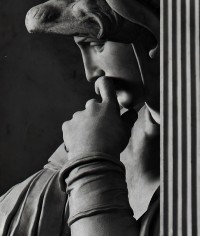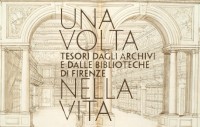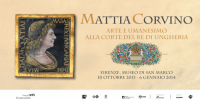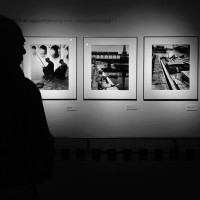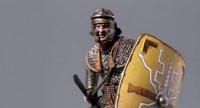By Daniela Quardrelli (University of Florence)
On the 450th anniversary of the death of Michelangelo Buonarroti (18 February 1564) the city of Florence rendered homage to the great sculptor through a series of expositions and conferences, among them was the exhibit “Il Potere dello Sguardo”, held by the Museo delle Capelle Medicee which ends on the 15th of March.
It is about more than 23 photographs, which portray the sculptures of Sagrestia Nuova, of the David and of the Prigioni (Prisoners) by Michelangelo realized through the photographs of Aurelio Amendola. Amendola, with his enlarged images, allows to closely observe so that we can almost ‘touch’ with our eyes the surfaces of Michelangelo’s sculptures. In this way, we can perceive the smoothness and the roughness of the material, the small ruts and natural imperfections of the marble. This perception is amplified using contrasting light and shadow that immerses us into the atmosphere of magic and mystery. This technique allows the sculptures to seem as if they are emerging from a chapel giving them a sacred aura. This technique stresses all the particulars that eyes less observant miss. It invites us to “enter the sculpture”, and proceeding as Michelangelo “per via di togliere”.
It seems as if we can touch the smooth face of Aurora, together with the small scratches on the surface of the marble. The seriousness of the Duca d’Urbino emerges from the enlargement of his gesture as well as the impressive musculature of the Giano, the modeling of the face of the mask adjacent the Notte, the plasticity of the skin folds and the mystery of the gaze of the Duca di Nemours.
The exposition is set up in the central part of the underground crypt, in the two lateral chapels and along the pathway, passing through the Cappella dei Principi, brings us to Sagrestia Nuova.
In the center of the crypt, the black and white photographs are supported with grey panels and are spaced by columns with capital moldings. The fitting seems to recall Renaissance architecture. In front of the entrance one of the panels has an opening topped with a triangular pediment opens the view on the altar of the crypt. At this point the evocative ambiance loses its aura with the presence of a bulky touchscreen, which without activity has a screensaver with lines in florescent colors.
How can the visitors immerse within the Renaissance atmosphere or perceive the sacredness of the place?
On the screen it shows a preview of the book “Michelangelo: La dotta Mano” and within this book there are 83 photographs of the masterpieces of Michelangelo (David, Prisoners, La Pieta, il San Sebastiano, il Tondo Doni, etc.) and drawings from Casa Buonarroti.
The lack of text panels makes it difficult to comprehend the message of the exhibit. In fact, the only instrument of information within the entire exhibit is the label of the photographs that report the subject, the material, and the height.
A cord is placed one meter from the panels and disturbs the visit. This security measure appears exaggerated because a few meters from them there is a security guard.
The lighting is realized with a lot of spotlights that are positioned at the same height of the panels, directly on the ceiling in order to diffuse the light homogeneously. Looking at the technique of the photographer and the works of Michelangelo, dim light could help with meditation and concentration, and if the spotlights were directed on the works, the photographs would be seen in the right way.
We can find inadequacy within the curating structure not only within the crypt but also on the second floor, where there are four photographs donated by the artist which are poorly visible due to the reflections on the cases.
Finally, with access to the Sagrestia Nuova we can admire the same work as seen in the photographs. Going towards the exit the visit is concluded with photos of the Prisoners, which are placed in a recess near the bookshop. Regrettably, the reliquaries are also placed here where visitors mistake them for purchasable items.
With the ticket of the exhibition, you can also visit the Museo della Cappelle Medicee.
For more information, visit the website:
http://www.polomuseale.firenze.it/mostre/mostra.php?t=52cd81f7f1c3bcfc070000e2
Il potere dello sguardo
Daniela Quadrelli (Università di Firenze)
A 450 anni dalla morte di Michelangelo Buonarroti (18 febbraio 1564) la città di Firenze rende omaggio al grande scultore attraverso una serie di esposizioni ed incontri, tra cui la mostra “Il potere dello sguardo” ospitata nel Museo delle Cappelle Medicee fino al 15 Marzo.
Si tratta di oltre 23 fotografie che ritraggono le sculture della Sagrestia Nuova, del David e dei Prigioni di Michelangelo realizzate dal fotografo Aurelio Amendola il quale, attraverso le sue “gigantografie”, ci permette di osservare da vicino, fin quasi a “toccare” con gli occhi, la superficie delle sculture Michelangiolesche, facendoci percepire la levigatezza e la ruvidità della materia, i piccoli solchi e le naturali imperfezioni del marmo. Questa percezione è amplificata dall’uso del contrasto luce/ombra che, oltre a farci immergere in un’atmosfera magica e misteriosa, sembra far emergere le sculture dal buio di una cappella conferendogli così un’aura di sacralità. Questa tecnica permette inoltre di sottoporre allo sguardo dell’osservatore quei particolari che un occhio poco attento non coglie, invitandoci ad “entrare dentro la scultura”, a procedere come Michelangelo “per via di togliere”.
Dell’Aurora ci sembra di poter toccare il suo volto liscio e candido, insieme alle piccole graffiature della superficie marmorea. La serietà del Duca d’Urbino emerge dall’ingrandimento del suo gesto così come l’imponente muscolatura del Giano, il modellato del volto della maschera che affianca la Notte, la plasticità della carne che mostra le sue pieghe e il mistero nello sguardo del Duca di Nemours.
L’esposizione è allestita nella parte centrale della cripta sotterranea, in due cappelle laterali e lungo il percorso che, passando per la Cappella dei Principi, porta alla Sagrestia Nuova.
Al centro della cripta, a supporto delle foto in bianco e nero, sono stati collocati una serie di pannelli grigi, intervallati da finte colonne con capitelli modanati. In questo modo l’allestimento sembra voler alludere alle sembianze di un’architettura Rinascimentale. Infatti dalla parte opposta dell’ingresso uno dei pannelli presenta un’apertura sormontata da un timpano triangolare che apre la vista prospettica sull’altare della cripta. A questo punto l’ambientazione evocativa perde la sua aura con la presenza di un ingombrante schermo touch, proprio in corrispondenza dell’apertura, che nei momenti di inattività manda in loop uno screensaver fatto di linee fluorescenti colorate. Come può l’osservatore calarsi nel Rinascimento e percepire la sacralità del luogo?
Così immersi nella realtà digitale sfogliamo in anteprima il volume “Michelangelo. La dotta mano” nel quale si raccolgono 83 scatti delle maggiori opere scultore di Michelangelo (il David, i Prigioni, la Pietà, Il San Sebastiano, il tondo Doni, etc.) a cui si affiancano disegni provenienti da Casa Buonarroti.
La mancanza di pannelli esplicativi rende un difficile comprendere il messaggio. Infatti l’unico strumento di informazione di tutta la mostra sono le didascalie poste accanto ad ogni fotografia che riportano il soggetto ritratto, il materiale e la sua altezza.
A penalizzare la visita è anche una corda posta a circa un metro di distanza dai pannelli: questa misura di sicurezza appare decisamente esagerata considerato che a pochi metri c’è la sorveglianza.
L’illuminazione invece è realizzata con un gran numero di faretti, posizionati all’altezza dei pannelli ma indirizzati sul soffitto in modo da creare una luce diffusa ed omogenea. Osservando la tecnica del fotografo e le opere di Michelangelo, la penombra aiuterebbe il raccoglimento e la concentrazione e, se i faretti fossero diretti sulle opere, queste potrebbero venir valorizzate nella giusta misura.
Una scarsa cura espositiva si ritrova anche al piano superiore dove vi sono 4 fotografie donate dall’artista le quali, essendo coperte da un vetro, sono malamente visibili a causa del riflesso.
Con l’accesso alla Sagrestia Nuova possiamo ammirare quelle stesse opere viste in fotografia. Avviandoci verso l’uscita la visita si conclude con le foto dei Prigioni collocate nella tribuna vicino al bookshop dove dispiace vedere come i pregiati reliquari della collezione permanente del museo siano affiancati a espositori di cartoline, quasi come se fossero anch’essi in vendita.
Nel biglietto della mostra è compresa la visita al Museo della Cappelle Medicee.
Per ulteriori informazioni, visitare il sito:
http://www.polomuseale.firenze.it/mostre/mostra.php?t=52cd81f7f1c3bcfc070000e2

